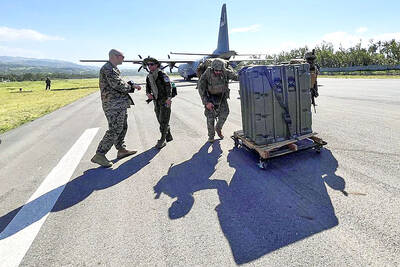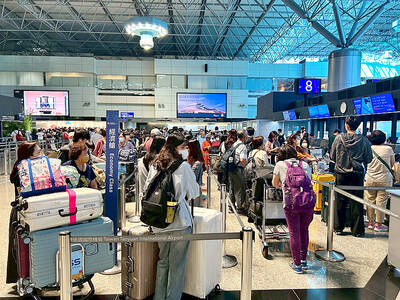To Wang Chong-ju (王重儒), a 31-year-old Taiwanese illustrator better known as Chiyou (蚩尤), female high-school students are characterized not only by their seemingly inexhaustible energy, but also by their perfectly ironed school shirts and pleated skirts.
Motivated by his fascination with the various designs and colors of high-school uniforms, Wang decided to make them the major theme for his much-anticipated new illustration book, titled Collection of Taiwan High School Girl Uniforms (制服至上:臺灣女高中生制服選).
The book features scores of slim female figures with youthful, silken complexions — the trademark of Wang’s illustration works — clad in the uniforms of 51 high schools in northern Taiwan, including Taipei First Girls’ High School, Taipei Jingmei Girls’ High School and the National Wuling Senior High School.

Photo: Fang Pin-chao, Taipei Times
It also includes drawings of young women wearing out-of-print school uniforms produced during the Japanese colonial period and the uniforms of some of the most well-known student clubs across the nation, such as Jingmei school’s tug-of-war team, Chih Ping Senior High School’s cheerleading team and Zhongshan Senior High School’s kendo club.
“These student clubs have achieved remarkable accomplishments that have made their fellow classmates very proud,” Wang said.
To ensure that the female students portrayed in his works look “pure and innocent,” Wang said he had laid down several ground rules in designing their appearance.
“Their hair cannot be permed or dyed, nor can they wear makeup or accessories. They also have to wear their uniforms properly without showing their cleavage,” Wang said.
Wang said all the illustrated figures wear the uniforms in a manner that conforms to school regulations.
“For instance, Daojiang Senior High School of Nursing and Home Economics regulations state that the school skirt must not be more than three finger-widths above the knees and students cannot sling their school bag across their chest,” Wang said.
Wang said he made a careful study of the details of each uniform to make sure his illustrations were “100 percent” accurate — from the school badges printed on shirt buttons to the patterns and the number of pleats on the skirts.
“The process of painting the uniforms was painstaking. To learn more details about the uniforms, I had to conduct careful research online, or approach female students on the streets,” he said.
“I also called up each of the schools asking them to provide me with more information,” he said.
The illustration book, his seventh, was published on Jan. 22 after two years in the making. Wang’s drawing talent has helped him make a name for himself in Japan and secure the opportunity to represent Taiwan at the 40th Angouleme International Comics Festival held in January last year in Angouleme, France.
Wang said he would consider creating illustrations featuring uniforms of schools from other parts of the country if his new publication is well-received.
He also encouraged readers to attend his book signing on Feb. 8 at the Taipei International Book Exhibition.
Those who come in school uniforms have a chance to win a special gift, he said.

Three batches of banana sauce imported from the Philippines were intercepted at the border after they were found to contain the banned industrial dye Orange G, the Food and Drug Administration (FDA) said yesterday. From today through Sept. 2 next year, all seasoning sauces from the Philippines are to be subject to the FDA’s strictest border inspection, meaning 100 percent testing for illegal dyes before entry is allowed, it said in a statement. Orange G is an industrial coloring agent that is not permitted for food use in Taiwan or internationally, said Cheng Wei-chih (鄭維智), head of the FDA’s Northern Center for

The Chinese military has built landing bridge ships designed to expand its amphibious options for a potential assault on Taiwan, but their combat effectiveness is limited due to their high vulnerability, a defense expert said in an analysis published on Monday. Shen Ming-shih (沈明室), a research fellow at the Institute for National Defense and Security Research, said that the deployment of such vessels as part of the Chinese People’s Liberation Army (PLA) Navy’s East Sea Fleet signals a strong focus on Taiwan. However, the ships are highly vulnerable to precision strikes, which means they could be destroyed before they achieve their intended

LOOKING NORTH: The base would enhance the military’s awareness of activities in the Bashi Channel, which China Coast Guard ships have been frequenting, an expert said The Philippine Navy on Thursday last week inaugurated a forward operating base in the country’s northern most province of Batanes, which at 185km from Taiwan would be strategically important in a military conflict in the Taiwan Strait. The Philippine Daily Inquirer quoted Northern Luzon Command Commander Lieutenant General Fernyl Buca as saying that the base in Mahatao would bolster the country’s northern defenses and response capabilities. The base is also a response to the “irregular presence this month of armed” of China Coast Guard vessels frequenting the Bashi Channel in the Luzon Strait just south of Taiwan, the paper reported, citing a

About 4.2 million tourist arrivals were recorded in the first half of this year, a 10 percent increase from the same period last year, the Tourism Administration said yesterday. The growth continues to be consistent, with the fourth quarter of this year expected to be the peak in Taiwan, the agency said, adding that it plans to promote Taiwan overseas via partnerships and major events. From January to June, 9.14 million international departures were recorded from Taiwan, an 11 percent increase from the same period last year, with 3.3 million headed for Japan, 1.52 million for China and 832,962 to South Korea,